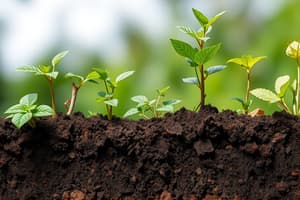Podcast
Questions and Answers
What is the primary objective of LAB NO: 1?
What is the primary objective of LAB NO: 1?
- To study soil health
- Degradation of octane
- Isolation of soil-degrading bacteria (correct)
- Analysis of UV radiation effects
Soil-degrading bacteria are known to worsen soil contamination.
Soil-degrading bacteria are known to worsen soil contamination.
False (B)
What type of hydrocarbons are studied in LAB NO: 3?
What type of hydrocarbons are studied in LAB NO: 3?
Octane
LAB NO: 4 deals with the degradation of ____ by soil bacteria using spray plate technique.
LAB NO: 4 deals with the degradation of ____ by soil bacteria using spray plate technique.
What were the characteristics of the colonies observed in the negative control?
What were the characteristics of the colonies observed in the negative control?
Match the labs with their main focus:
Match the labs with their main focus:
Which process do soil-degrading bacteria contribute to?
Which process do soil-degrading bacteria contribute to?
The test plate showed significantly larger and well-formed colonies.
The test plate showed significantly larger and well-formed colonies.
What type of cells were primarily observed in the positive control after 10 minutes of UV exposure?
What type of cells were primarily observed in the positive control after 10 minutes of UV exposure?
Which of the following species is oxidase-positive?
Which of the following species is oxidase-positive?
UV radiation has no effect on bacteria.
UV radiation has no effect on bacteria.
The methodology used in the experiment involved observing bacteria exposed to ___ radiation.
The methodology used in the experiment involved observing bacteria exposed to ___ radiation.
Polycyclic aromatic hydrocarbons (PAHs) are not considered mutagenic or carcinogenic.
Polycyclic aromatic hydrocarbons (PAHs) are not considered mutagenic or carcinogenic.
What environmental problem is associated with greasy soil?
What environmental problem is associated with greasy soil?
Match the observation condition with its outcomes:
Match the observation condition with its outcomes:
What ecological process does the degradation of benzene by microorganisms contribute to?
What ecological process does the degradation of benzene by microorganisms contribute to?
Soil-degrading bacteria can transform pollutants into more or less ____ forms.
Soil-degrading bacteria can transform pollutants into more or less ____ forms.
The cotton-soaked method is used to study the biodegradation of __________ by soil bacteria.
The cotton-soaked method is used to study the biodegradation of __________ by soil bacteria.
Match the following controls with their descriptions:
Match the following controls with their descriptions:
What is the purpose of making wells in the plates during the experiment?
What is the purpose of making wells in the plates during the experiment?
Incubation of the plates occurs at a temperature of 25°C.
Incubation of the plates occurs at a temperature of 25°C.
What method is used to isolate individual bacterial colonies in the experiment?
What method is used to isolate individual bacterial colonies in the experiment?
What type of media was used in the experiment to observe microbial growth?
What type of media was used in the experiment to observe microbial growth?
Fungal contamination was observed only on one of the plates during the experiment.
Fungal contamination was observed only on one of the plates during the experiment.
What are the names of the two bacterial genera mentioned that were viable on nutrient agar?
What are the names of the two bacterial genera mentioned that were viable on nutrient agar?
During the experiment, fungal contamination on the filter paper suggested that the experimental conditions favored _____ growth.
During the experiment, fungal contamination on the filter paper suggested that the experimental conditions favored _____ growth.
Match the following microbial aspects with their relevance to the experiment:
Match the following microbial aspects with their relevance to the experiment:
What could be a potential future direction to reduce contamination in experiments?
What could be a potential future direction to reduce contamination in experiments?
The presence of diesel in the environment does not pose any ecological risks.
The presence of diesel in the environment does not pose any ecological risks.
What role did the filter paper serve during the experiment?
What role did the filter paper serve during the experiment?
What is the primary objective of the study?
What is the primary objective of the study?
The study shows that Bacillus and Pseudomonas are effective in degrading benzene.
The study shows that Bacillus and Pseudomonas are effective in degrading benzene.
What are two environmental sources of hydrocarbons mentioned in the content?
What are two environmental sources of hydrocarbons mentioned in the content?
The type of media used to grow Bacillus and Pseudomonas was called _____ media.
The type of media used to grow Bacillus and Pseudomonas was called _____ media.
Match each microorganism to its expected result in the study:
Match each microorganism to its expected result in the study:
Which of the following represents a potential risk of hydrocarbons in the environment?
Which of the following represents a potential risk of hydrocarbons in the environment?
The tests conducted showed positive results for both bacterial species at all experimental stages.
The tests conducted showed positive results for both bacterial species at all experimental stages.
What method was used on Day 1 to prepare a master plate?
What method was used on Day 1 to prepare a master plate?
What is bioremediation primarily used for?
What is bioremediation primarily used for?
The positive control plate had diesel sprayed on it.
The positive control plate had diesel sprayed on it.
Which two genera of bacteria were tested for diesel degradation?
Which two genera of bacteria were tested for diesel degradation?
The agar plate marked as the __________ control confirmed bacterial viability on the minimal media.
The agar plate marked as the __________ control confirmed bacterial viability on the minimal media.
Match the bacterial growth levels with their corresponding observations.
Match the bacterial growth levels with their corresponding observations.
What method was used to evaluate the bacteria's ability to metabolize diesel?
What method was used to evaluate the bacteria's ability to metabolize diesel?
The study indicated that these bacteria can effectively degrade diesel.
The study indicated that these bacteria can effectively degrade diesel.
How long were the plates incubated during the experiment?
How long were the plates incubated during the experiment?
Flashcards
Soil-degrading bacteria
Soil-degrading bacteria
Microorganisms that break down organic matter in soil, playing a crucial role in nutrient cycling and maintaining soil health.
Soil degradation
Soil degradation
The process by which soil-degrading bacteria break down organic matter in soil.
Complex pollutants
Complex pollutants
Pollutants that can be broken down by certain bacteria into simpler, often less harmful compounds.
Greasy soil
Greasy soil
Signup and view all the flashcards
Mutagenesis
Mutagenesis
Signup and view all the flashcards
Spray plate technique
Spray plate technique
Signup and view all the flashcards
Isolation
Isolation
Signup and view all the flashcards
Nutrient-rich agar
Nutrient-rich agar
Signup and view all the flashcards
Serial Dilution
Serial Dilution
Signup and view all the flashcards
Oxidase Test
Oxidase Test
Signup and view all the flashcards
Hydrocarbons
Hydrocarbons
Signup and view all the flashcards
Polycyclic Aromatic Hydrocarbons (PAHs)
Polycyclic Aromatic Hydrocarbons (PAHs)
Signup and view all the flashcards
Biodegradation
Biodegradation
Signup and view all the flashcards
Cotton-soaked Method
Cotton-soaked Method
Signup and view all the flashcards
Positive Control
Positive Control
Signup and view all the flashcards
Negative Control
Negative Control
Signup and view all the flashcards
Minimal medium
Minimal medium
Signup and view all the flashcards
Bioremediation
Bioremediation
Signup and view all the flashcards
Hydrocarbon degradation
Hydrocarbon degradation
Signup and view all the flashcards
Bacillus
Bacillus
Signup and view all the flashcards
Pseudomonas
Pseudomonas
Signup and view all the flashcards
Stabbing culture
Stabbing culture
Signup and view all the flashcards
Hydrocarbon utilization
Hydrocarbon utilization
Signup and view all the flashcards
Nutrient agar
Nutrient agar
Signup and view all the flashcards
Microbial Culture
Microbial Culture
Signup and view all the flashcards
Replication (Microbial)
Replication (Microbial)
Signup and view all the flashcards
Fungal Contamination
Fungal Contamination
Signup and view all the flashcards
Hydrocarbon-Degrading Bacteria
Hydrocarbon-Degrading Bacteria
Signup and view all the flashcards
Aseptic Techniques
Aseptic Techniques
Signup and view all the flashcards
UV-induced mutagenesis
UV-induced mutagenesis
Signup and view all the flashcards
Lethal & sub-lethal mutations
Lethal & sub-lethal mutations
Signup and view all the flashcards
Growth density difference
Growth density difference
Signup and view all the flashcards
Microscopic observation of UV damage
Microscopic observation of UV damage
Signup and view all the flashcards
Colony morphology changes
Colony morphology changes
Signup and view all the flashcards
Study Notes
Environmental Mutagenisis Lab Manual - MIC-637
- Lab course in charge: Ms. IQra
- Student name: Kainaat
- Seat no: EH2121042
Index (Lab Experiments)
- Lab No. 1 (15-10-2024): Isolation of soil-degrading bacteria
- Lab No. 2 (22-10-2024): Degradation of benzene from soil microorganisms using the cotton soak method.
- Lab No. 3 (22-10-2024): Degradation of hydrocarbons (octane) by soil microorganisms.
- Lab No. 4 (4-12-2024): Degradation of hydrocarbon (diesel) by soil bacteria using spray plate technique.
- Lab No. 5 (11-12-24): UV radiation induces mutagenesis in bacteria.
Lab No. 1: Isolation of Soil-Degrading Bacteria
- Objective: Isolate soil-degrading bacteria
- Introduction: Soil bacteria break down organic matter, crucial for soil health and nutrient cycling. Some bacteria can transform pollutants into mutagenic compounds.
- Soil Bacteria Types: Pseudomonas and Bacillus are effective in hydrocarbon degradation.
- Sample Collection: 1 gram of greasy soil from a petrol pump collected.
- Methods:
- Serial dilution of soil sample (diluted to 10-¹ to 10-⁶)
- Plating: 0.1mL of dilutions spread on nutrient agar plates.
- Incubation: Plates incubated at 37°C for 24 hours.
Lab No. 2: Degradation of Benzene by Soil Microorganisms
- Objective: Observe benzene degradation by soil microorganisms
- Introduction: Benzene, a common pollutant, is degraded by some soil microorganisms through various processes, often involving breaking down the compound into less harmful substances.
Lab No. 3: Degradation of Hydrocarbons (Octane)
- Objective: Observe degradation of octane by soil microorganisms.
- Introduction: Octane is a hydrocarbon commonly found in petroleum, and soil microorganisms play a vital role in its degradation.
- Methodology: Use a minimal media to observe growth patterns, as well as replicate of cultures using a sterile replicator.
Lab No. 4: Degradation of Hydrocarbons (Diesel)
- Objective: Observe degradation of diesel by soil bacteria using a spray plate technique.
- Introduction: Diesel is a complex mixture of hydrocarbons and degrading it is an environmental problem.
- Methodology: Spray diesel onto minimal media plates and observe bacterial growth.
Lab No. 5: UV Radiation and Mutagenesis in Bacteria
- Objective: Determine the effects of UV radiation on bacterial mutagenesis.
- Introduction: UV radiation can cause DNA mutations in bacteria, potentially impacting their survival and growth.
- Methodology: Expose bacterial cultures (Pseudomonas) to different UV radiation durations (10 minutes, 20 minutes) and observe the results on minimal media plates.
Studying That Suits You
Use AI to generate personalized quizzes and flashcards to suit your learning preferences.
Related Documents
Description
This lab manual focuses on environmental mutagenesis, detailing experiments aimed at isolating soil-degrading bacteria and understanding their role in pollutant degradation. Students will conduct a series of experiments analyzing the effectiveness of various soil microorganisms in breaking down hydrocarbons and the impact of UV radiation on mutagenesis. Each lab is designed to enhance practical skills in microbiology and environmental science.




